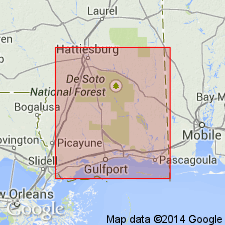
- Usage in publication:
-
- Andrew Formation*
- Modifications:
-
- Named
- Dominant lithology:
-
- Shale
- Limestone
- AAPG geologic province:
-
- Mid-Gulf Coast basin
- Gulf Coast basin
Summary:
Pg. D45 (table), D46-D47. Andrew Formation. Generally marine rocks, previously called "Pre-Dantzler rocks of Washita and Fredericksburg groups, undifferentiated" (Nunnally and Fowler, 1954, Mississippi Geol. Survey Bull., no. 79). Consists, toward top, of dull- to dark-red, gray, and olive-gray shale containing beds of brownish-gray finely sandy limestone, some shell fragments, and some beds of olive-gray dolomite and light-cream limestone. Grades downward into gray and greenish-gray to dull-red micaceous shale alternating with limestone, minor beds of fine-grained sandstone containing some carbonaceous matter, and grayish-green siltstone. Much of lower part is dark-gray shale. Thickness 1,000 to 1,880 feet. Recognized in subsurface across southern Mississippi and adjoining states [Alabama and Louisiana]. Age is Early Cretaceous.
Type section (subsurface): depth-interval 9,800 to 11,360 ft, Gulf Oil Company No. 25 J.M. Andrew well, Baxterville oil field, in sec. 6, T. 1 N., R. 16 W., Lamar Co., central MS.
Source: US geologic names lexicon (USGS Bull. 1350, p. 26).
For more information, please contact Nancy Stamm, Geologic Names Committee Secretary.
Asterisk (*) indicates published by U.S. Geological Survey authors.
"No current usage" (†) implies that a name has been abandoned or has fallen into disuse. Former usage and, if known, replacement name given in parentheses ( ).
Slash (/) indicates name conflicts with nomenclatural guidelines (CSN, 1933; ACSN, 1961, 1970; NACSN, 1983, 2005, 2021). May be explained within brackets ([ ]).

